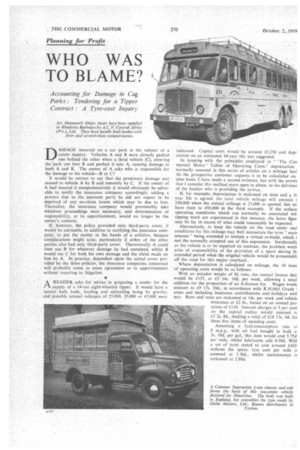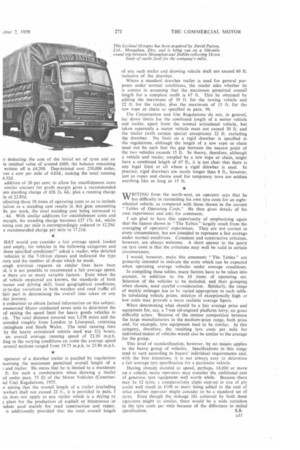Planning for Profit
Page 112

Page 113

If you've noticed an error in this article please click here to report it so we can fix it.
WHO WAS TO BLAME?
Accounting for Damage in Ca‘ Parks : Tendering for a Tipper Contract : A Tyre-cost Inquiry
DAMAGE incurred on a car park is the subject of a recent inquiry. Vehicles A and B were already parked one behind the other when a third vehicle (C), entering the park ran into B and pushed it into A, causing damage to both A and B. The owner of A asks who is responsible for the damage to his vehicle—B or C?
It would be correct to say that the proximate damage was caused to vehicle A by B and remotely by C. If the owner of A had insured it comprehensively it would obviously be advisable to notify the insurance company accordingly, adding a proviso that as the innocent party he did not expect to be deprived of any no-claim bonus which may be due to him. Thereafter, the insurance company would presumably take whatever proceedings were necessary, and determination of responsibility, or its apportionment, would no longer be the owner's concern.
If, however, the policy provided only third-party cover, it would be advisable, in addition to notifying the insurance company, to put the matter in the hands of a solicitor, because complications might arise, particularly if either of the other parties also had only third-party cover. Theoretically A could then sue B for whatever damage he had sustained, whilst B would sue C for both his own damage and the claim made on him by A. In practice, dependent upon the actual cover provided by the three policies, the insurance companies concerned will probably come to some agreement as to apportionment without resorting to litigation.
AREADER asks for advice in preparing a tender for the supply of a 14-ton eight-wheeled tipper. It would have a special, bulk body, loading and unloading being by gravity. and possible annual mileages of 25.000, 35.000 or 45.000 were indicated. Capital costs would be around £5.250 and depr, ciation on an estimated 10-year life was suggested.
In keeping with the principles employed in ' The Con mercial Motor' Tables of Operating Costs," depreciation normally assessed in this series of articles on a mileage basi As the prospective customer requests it to be calculated on time basis. I have made a second estimate, but with the provis that I consider this method more open to abuse, to the detrimer of the haulier who is providing the service.
If, for example, depreciation is reckoned on time and a 1( year life is agreed. the total vehicle mileage will amount t 250,000 when the annual mileage is 25.000 as quoted, but wil have risen to 450,000 in the third example. If the arduou operating conditions which can normally be associated witl tipping work are experienced in this instance, the latter figur may be far in excess of what could reasonably be expected.
Alternatively, to keep the vehicle on the road under sue) conditions for this mileage may *ell necessitate the term "main tenance " being extended to include a virtual re-build, which i not the normally accepted use of this expression. Incidentally as the vehicle is to be supplied on contract, the problem woull arise of responsibility of the provision of a spare during th extended period when the original vehicle would be presumabl2 off the road for this major overhaul...
Where depreciation is calculated on mileage, the 10 item! of operating costs would be as follows:
With an unladen weight of 8:1 tons, the annual licence dut■ would be £135, or £2 14s. 10d. per week, allowing a smal addition for the proportion of an A-licence fee. Wages woulc amount to £9 17s. 10d., in accordance with R.H.(66) Grade areas and including insurance contributions and holidays with pay, Rent and rates are reckoned at 14s. per week and vehicle insurance at £2 4s., based on an annual premium of £110. Interest charges at 3 per cent on the capital outlay would amount tc £3 2s. 8d., making a total of £18 13s. 4d. feu these five items of standing costs.
Assuming a fuel-consumption rate ol 8 m.p.g.. with oil fuel bought in bulk at 3s. 10d. per gal., this item would cost 5.75d per mile, whilst lubricants add 0.30d. With a set of tyres stated to cost around £420 without the spare, tyre cost per mile is assessed at 3.36d., whilst maintenance is reckoned at 2.88d. e• deducting the cost of the initial set of tyres and an te residual value of around £600, the balance remaining written off is £4,200. -Depreciated over 250,000 miles, yes a cost per mile of 4.03d1, making the total running 6.32d.
addition of 20 per cent. to allow for establishment costs similar amount for profit margin gives a recommended urn standing charge of £26 2s. 6d,, plus a running charge le of 22.85d.
tdjusting these 10 items of operating costs so as to include :iation as a standing cost results in this Item amounting 8s. per week, the total standing cost being increased to . 4d. With similar additions for establishment costs and margin, the standing charge becomes £37 17s. 6d., whilst ruling cost per mile is correspondingly reduced to 12.29d. e recommended charge per mile to 17.21d.
HAT would you consider a fair average speed, loaded and empty, for vehicles in the following categories and these specified conditions?" asked a reader, who detailed vehicles in the 7-10-ton classes and indicated the type rney and the number of drops Which he made.
lough previous requests on similar lines have been
it is not possible to recommend a fair average speed, ;a there are so many variable factors. Even when the of vehicle employed are known, the standards of both :name and driving skill, local geographical conditions, ty-to-day variations in both weather and road traffic all heir part in determining the overall tinie taken on any ilar journey.
n endeavour to obtain factual information on this subject, ommercial Motor conducted seven tests to determine the of raising the .speed limit for heavy goods vehicles to ah. The total distance covered was 1,178 miles and the :xtended roughly from London to Liverpool, returning rmingham and South Wales. The total running time by the heavy articulated vehicle used was 524 hours, an overall average running speed of 22.20 m.p.h. sing to the varying conditions en route the average speed several sections ranged from 19.75 m.p.h. to 23.80 m.p.h.
operator of a drawbar trailer is puzzled by regulations nc,erning the maximum permitted overall length of a and trailer. He states that he is limited to a maximum ft. for such a combination when drawing a trailer ed under para. 53 (1) of the Motor Vehicles (Construerid Use) Regulations, 1955.
T stating that the overall length of a trailer (excluding .awbar) shall not exceed 22 ft., it is provided in para. f us does not apply to any trailer which is a drying or• ; plant for the production of asphalt or bituminous or :aclarn used mainly for road construction and repair. is additionally provided that the total overall length of any such trailer and drawing vehicle shall not exceed 60 ft. inclusive of the drawbar, Where a standard drawbar trailer is used for general purposes under normal conditions, the reader asks whether he is correct in assuming that the maximum permitted overall length for a complete outfit is 67 ft This he obtained by adding the maximum of 30 ft. for the towing vehicle and 22 ft. for the trailer, Plus the maximum of 15 ft. for the tow rope or chain as specified in para. 94.
The Construction and Use Regulations do not, in general, lay down limits for the combined length of a motor vehicle and trailer, apart from the normal articulated vehicle, but taken separately a motor vehicle must not exceed 30 ft. and the trailer (with certain special exceptions) 22 ft. excluding the drawbar. No limit on a rigid drawbar is specified in the regulations, although the length of a tow rope or chain must not be such that the gap between the nearest point of the two vehicles exceeds 15 ft. In theory, therefore, although a vehicle and trailer, coupled by a tow rope or chain, might have a combined length of 67 ft., it is not clear that there is any legal limit at an where a rigid drawbar is used. In practice, rigid drawbars are rarely longer than 8 ft., however, just as ropes and chains used for temporary tows are seldom anything like as long as 15 ft.
TR1TING from the north-west, an operator say.s that he TV has difficulty in reconciling his own tyre costs for an eightwheeled vehicle, as compared with those shown in the current "Tables of Operating Costs." He then gives detail.; of his own experiences and asks for comments.
I am glad to have this opportunity of emphasizing again that the figures shown in "The Tables" largely :result from the averaging of operators' experiences. They are not correct in every circumstance, but are intended to represent a fair average under normal conditions.. Comment and constructive criticism, however, are always welcome. A short answer to the query on tyre costs is that the criticisms may well be valid in certain circumstances,
I would, however, make this comment "The Tables" are primarily intended to indicate the costs which can be expected when operating average vehicles under average conditions.
In compiling these tables, many factors have to be taken into account, in addition to the 10 items of operating oat. Selection of the vehicles to be included, and their grouping when chosen, need careful consideration: -Similarly, the range of weekly mileages has to he varied appropriate to each table. In tabulating vehicle prices, deletion of exceptionally high or low costs may provide a more realistic average figure.
When determining what should be a fair average price and equipment for, say, a 7-ton oil-engined platform lorry, no great difficulty arises. Because of the intense Competition between the large manufacturers in the medium-price range, both price and,' for example, tyre equipment tend to be similar. In this category, therefore, the resulting tyre costs per mile for individual makes of vehicles would also be similar to theaverage for the group.
This level of standardization, however, by no means applies to the heavy group of vehicles. Specifications in this range tend to vary according to buyers' individual requirements and, with the best intentions, it is not alway§ easy to determine a fair average tyre specification for a particular vehicle.
Having already decided to spend, perhaps, £4,000 or more on a vehicle, many operators may consider the additional cost of generous tyre equipment well worth while: Because there may be 12 tyres, a comparatively slight step-up in size of ply could well result in £100 or more being added to the cog of what another operator might consider to be a standard set of tyres, Even though the mileage life achieved by both these operators .might be similar, therewould be a wide variation in the tyre costs per mile because of the difference in initial
specification, S.R.












































































































































































































































